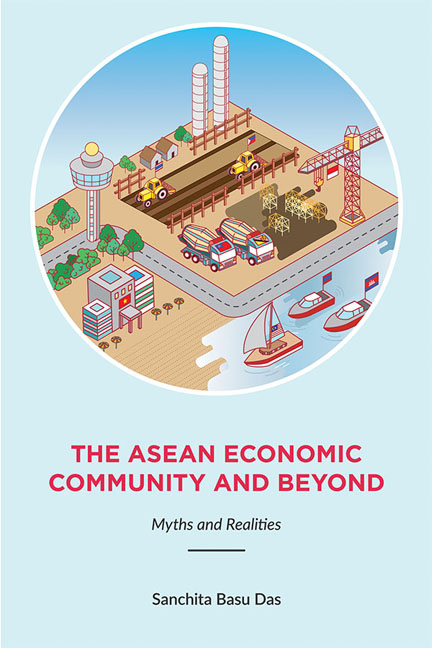Book contents
- Frontmatter
- Dedication
- Contents
- Foreword
- Acknowledgements
- Abbreviations
- 1 Introduction: The ASEAN Economic Community and Beyond
- I THE ASEAN ECONOMIC COMMUNITY (AEC)
- II BEYOND THE ASEAN ECONOMIC COMMUNITY
- 9 The Regional Comprehensive Economic Partnership: Going Beyond ASEAN+1 FTAs
- 10 Comparing ASEAN+1 FTAs for an Effective RCEP
- 11 Challenges in Negotiating the Regional Comprehensive Economic Partnership Agreement
- 12 The Next Decade in ASEAN-U.S. Economic Relations
- 13 RCEP and TPP: Comparisons and Concerns
- 14 The Trans-Pacific Partnership (TPP): Economic and Strategic Implications for the Asia-Pacific
- 15 The Trans-Pacific Partnership as a Tool to Contain China: Myth or Reality?
- 16 RCEP and TPP: Can They Converge into an FTAAP?
- 17 Is APEC's Relevance Fading?
- III AN ASEAN PERSPECTIVE OF REGIONAL CONNECTIVITY
- Appendix: Summary of the Trans-pacific Partnership Agreement
- Index
- About the Author
16 - RCEP and TPP: Can They Converge into an FTAAP?
from II - BEYOND THE ASEAN ECONOMIC COMMUNITY
Published online by Cambridge University Press: 19 May 2017
- Frontmatter
- Dedication
- Contents
- Foreword
- Acknowledgements
- Abbreviations
- 1 Introduction: The ASEAN Economic Community and Beyond
- I THE ASEAN ECONOMIC COMMUNITY (AEC)
- II BEYOND THE ASEAN ECONOMIC COMMUNITY
- 9 The Regional Comprehensive Economic Partnership: Going Beyond ASEAN+1 FTAs
- 10 Comparing ASEAN+1 FTAs for an Effective RCEP
- 11 Challenges in Negotiating the Regional Comprehensive Economic Partnership Agreement
- 12 The Next Decade in ASEAN-U.S. Economic Relations
- 13 RCEP and TPP: Comparisons and Concerns
- 14 The Trans-Pacific Partnership (TPP): Economic and Strategic Implications for the Asia-Pacific
- 15 The Trans-Pacific Partnership as a Tool to Contain China: Myth or Reality?
- 16 RCEP and TPP: Can They Converge into an FTAAP?
- 17 Is APEC's Relevance Fading?
- III AN ASEAN PERSPECTIVE OF REGIONAL CONNECTIVITY
- Appendix: Summary of the Trans-pacific Partnership Agreement
- Index
- About the Author
Summary
Policymakers in Asia and the Pacific view the RCEP and the TPP as pathways to a Free Trade Area for Asia-Pacific (FTAAP) that will be comprehensive and of high quality and that will harmonize the rules of integration of the existing smaller scale FTAs in the region. An FTAAP, using either of the TPP or the RCEP pathways, is possible if endorsed by major powers like the United States, Japan and China. The most widely heard comment on the FTAAP idea is that it is unlikely to happen because of the political conflict between major economies like the United States and China. Currently, there are two possible scenarios: (a) The RCEP and the TPP will merge to form an FTAAP; or (b) the RCEP and the TPP will remain separate and without the United States and China having dual membership. Considering the pros and cons on both sides, it is more likely that the RCEP and the TPP will remain separate. Within this fluid context, it is imperative for ASEAN to maintain its “centrality” and to respond effectively to potential conflicts arising out of the RCEP and TPP agreements. ASEAN states recognize the benefit of having both the United States and China as key partners, and they can be expected to continue keeping both of them interested in the regional trading architecture.
INTRODUCTION
Over the last two years, two mega regional trade agreements (RTAs) — the Regional Comprehensive Economic Partnership (RCEP) and the Trans-Pacific Partnership (TPP) — are being negotiated to generalize the bilaterals and smaller regional agreements into more coherent regionwide or crossregional arrangements. While RCEP negotiations involve sixteen countries (the ten ASEAN member countries, plus China, Japan, South Korea, India, Australia and New Zealand) aiming to attain a comprehensive and mutually beneficial economic partnership agreement that will entail deeper engagement between ASEAN and its FTA partners, TPP negotiations involve twelve countries (Australia, Brunei, Canada, Chile, Japan, Malaysia, Mexico, New Zealand, Peru, Singapore, the United States and Vietnam) and the aim is to liberalize trade in goods and services; encourage investments; promote innovation, economic growth and development; and support job creation and retention. However, both the RCEP and the TPP are currently facing complex challenges and are encountering difficulties in reaching a conclusion.
- Type
- Chapter
- Information
- The ASEAN Economic Community and BeyondMyths and Realities, pp. 165 - 175Publisher: ISEAS–Yusof Ishak InstitutePrint publication year: 2015



